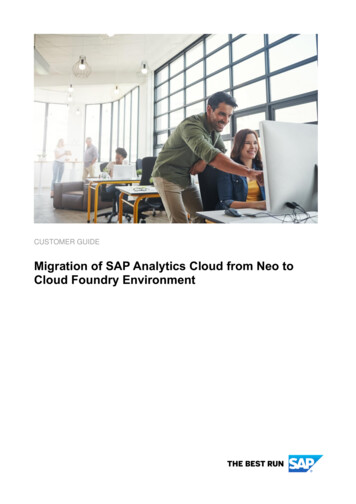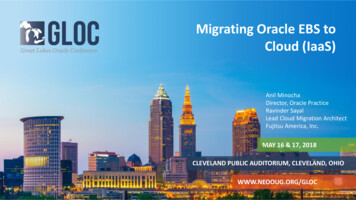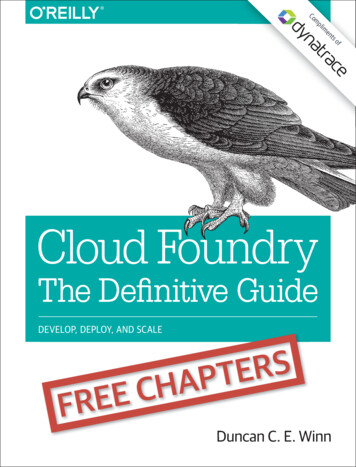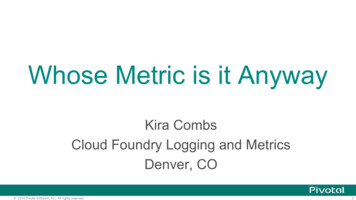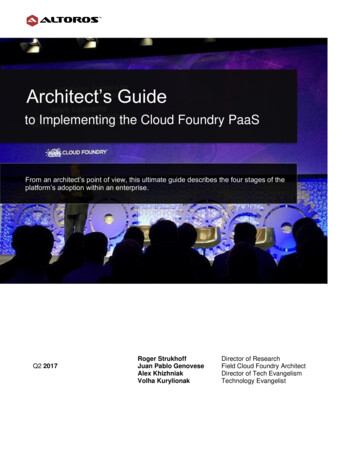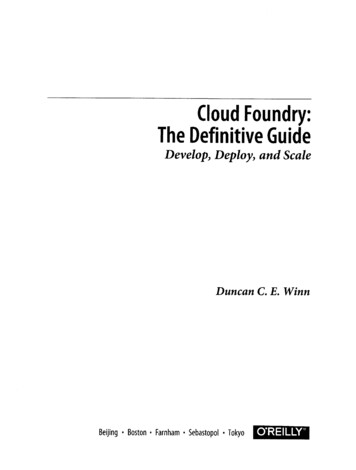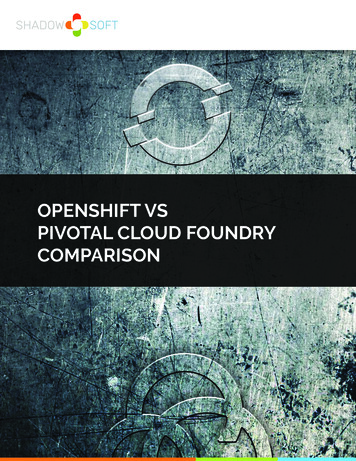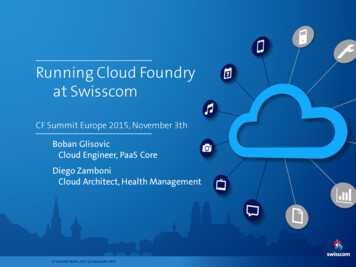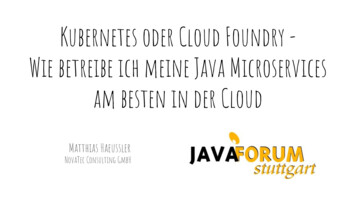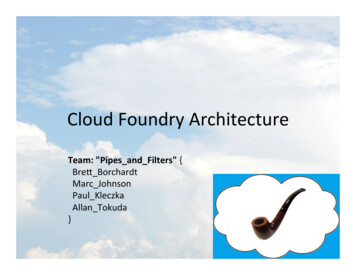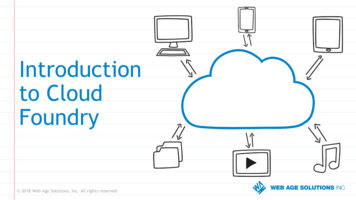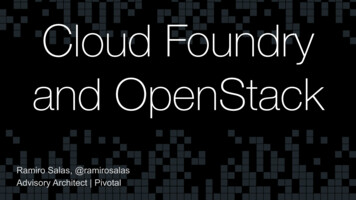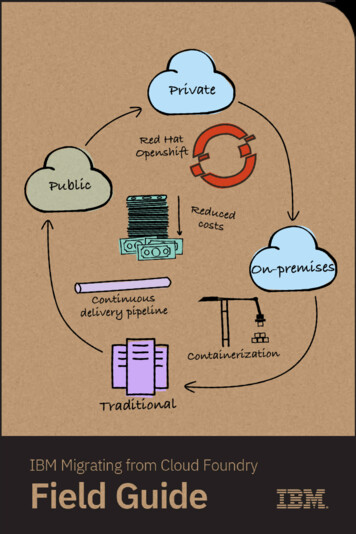
Transcription
IBM Migrating from Cloud FoundryField Guide
Download the current version of the IBMMigrating from Cloud Foundry Field dry-field-guide Copyright International Business Machines Corporation 2020, 2021. USGovernment Users Restricted Rights - Use, duplication or disclosure restrictedby GSA ADP Schedule Contract with IBM Corp.
Change is coming. Are youready?Over the past few years, there has been growing acceptance ofKubernetes as an industry standard. To support this emergingstandard, all major Cloud Service Providers (CSP) have a client offeringto manage and support this technology.THE MARKET HAS SPOKEN. FUTURE-PROOF YOUR ECOSYSTEMShift in the industry. Kubernetes brings to market capabilities thatenable interoperability, improved scalability, and increased operationalefficiency.Support from the open source community. Kubernetes has gainedtremendous support from the open source community. Open sourcecollaboration continues to expand the core capabilities that supportother emerging technologies such as edge computing and networkfunctions running as containers.Rethink future IT investments. Use the automation capabilities ofRed Hat OpenShift to enable your enterprise to increase operationalefficiencies that yield better return on investment (ROI) with reducedtotal cost of ownership (TCO).What’s inside?This field guide provides a high-level overview of migrating to IBM’sopen platform strategy.LEARN ITA summary of the concepts.GET STARTEDTips to start the journey to shift toan open platform.
LEARN ITReduce cost. Increase speedand agility.Business transformation and cloud adoption can yield costsavings, speed, and agility. As you modernize legacy applications,your organization can achieve value and benefit by incorporatingKubernetes as part of your cloud transformation. Red Hat OpenShift isa platform to help you more easily achieve your transformation goals.CLOUD TECHNOLOGY MUST WORK FOR YOU, NOT VICE VERSAMove between on-premises and public cloud. With Red HatOpenShift your organization gains the ability to move between onpremises and public cloud to better manage total cost of ownership(TCO) and return on investment (ROI).Establish standard processes. Red Hat OpenShift on IBM Cloud offersunique security and productivity capabilities designed to eliminatetime spent on updating, scaling, and provisioning assets. It has theresiliency to handle unexpected surges and protects against attacksthat can lead to financial and productivity losses.Integrate with your delivery pipeline. Reduce disruption to yourdeveloper experience and increase speed of delivery by integratingthe platform with your existing continuous integration and deliverypipeline.Learn moreWhy Red Hat OpenShift?https://www.openshift.com/2
More and more, organizations that consume Cloud Foundry as theirbase application development platform are revisiting their cloudtransformation strategy. Cloud Foundry has limits when it comes tomodernizing some legacy applications. This can pose a substantialsetback if you expected to move legacy applications to the cloudwithout having to refactor them all.
LEARN ITChoose the right platformYou need a platform built on open source technologies that works onmultiple public and private clouds, enables integration with the cloudprovider platform, and isolates teams from vendor lock-in. Based onthese needs, IBM chose Red Hat Enterprise Linux and Red Hat OpenShiftas our hybrid multicloud platform.Red Hat OpenShift on IBM Cloud, an as-a-service offering, is a fullymanaged OpenShift 4 service that uses the enterprise scale and securityof IBM Cloud. It provides the best combination of flexibility in choosingwhere your workloads run and assurance that they will run predictablyand securely.TRANSFORM YOUR WORKLOADSLearn moreDiscover why IBM chose Red Hat OpenShift as it’s open, hybrid, multicloud chitectures/open-cloud-platform/4
Built in security. Red Hat OpenShift adds comprehensive security toupstream Kubernetes with built-in authentication and authorization,secrets management, auditing, logging, and an integrated containerregistry for granular control over resources and user permissions. Theplatform integrates tightly with Jenkins and other standard CI/CD toolsfor security-focused application builds.Enhanced operator support. Red Hat OpenShift 4 automates theinstallation, updates, and management of the full stack—from theunderlying infrastructure (IBM Cloud, Amazon Web Services, vSphere,Microsoft Azure, Red Hat OpenStack Platform, etc.), to the Red HatLinux OS (RHCOS), to the Kubernetes platform and integrated services(Red Hat OpenShift).Operators enable consistent deployment of services across multipleinstances. Updates and security patches can be regularly pushed tomachines without requiring intervention by administrators.Integrated service mesh. Red Hat OpenShift Service Mesh movesthe logic governing the service-to-service communication betweencontainers from the individual services and abstracts it to a layer ofinfrastructure. The Red Hat OpenShift Service Mesh uses componentsfrom open source projects Istio, Jaeger, and Kiali. By integratingthese tools together in a single package, the service mesh deliversinterconnection, tracing, and visualization. This enables rapidtroubleshooting of the service mesh and enables operations teams toquickly react to changes.Support for serverless workloads. Red Hat OpenShift uses Knative toestablish a foundation to manage serverless workloads. By targeting theserverless framework to use Knative application programming interfaces(APIs), it is possible to bridge serverless and Kubernetes. Whendeploying a service, Knative starts and stops the service as needed.
LEARN ITShift to agile DevOpsAs you plan your strategy to transform away from Cloud Foundryto Red Hat OpenShift, you need to integrate the right methodologywith the platform, DevOps tools, and practices that will help youaccomplish your goals of being faster, stronger, adaptable, and moreprofitable.THE RIGHT METHOD FOR YOUR CLOUD TRANSFORMATIONTransform your culture. Build the organizational agility neededto adapt and address the complexity associated with the shift intechnology by up skilling development and operations to supportthe Red Hat OpenShift platform. Enable business, development, andoperations to continuously design, deliver, and validate new solutionsusing Red Hat OpenShift technologies.Increase velocity and improve quality. Implement the prescriptiveguidance in the IBM Garage Methodology practices and workflowsto enable your cloud adoption and transformation based on reusablemigration patterns. Adapt them to your company’s specific cloudjourney and culture to minimize disruption.Concentrate on Ops. Incorporate security (DevSecOps), productmanagement (BizDevOps), and infrastructure agility (GitOps) intoyour DevOps adoption to meet all of your operational needs tosupport day-2 operations for a Red Hat Open IT ecosystem.Learn moreAdopt the IBM Garage Method for Cloud.https://www.ibm.com/garage/method/cloud6
Adopt the Garage Methodology to ensure system reliability and stability for an “always available” user experience.
LEARN ITAutomate your DevOpsIncrease your organization’s DevOps maturity by defining automatedprocesses that drive applications through the build, test, and deploypipeline. Defining these repeatable patterns establishes consistentprocesses and standards and increases your deployment success rateby minimizing human interaction, which can reduce errors during codedeployments.SMARTER, SCALABLE, SHAREABLE AUTOMATIONBuild a highly available infrastructure. Ensure that your app is alwaysavailable and meets your service level requirements. By moving tothe cloud, DevOps teams don’t need to maintain server hardware oroperating systems.Manage your cloud resources. Use auto-scaling to ensure thatresources are available at peak times and save costs by reducing theallocated resource required during low usage times.Automate using pipelines. Easily deploy across multiple cloud providersor hybrid environments by using Red Hat OpenShift Pipelines, aKubernetes-style CI/CD solution based on Tekton. Using the Tekton opensource project, you can quickly create cloud-native CI/CD pipelines.Tekton uses the Kubernetes control plane to run pipeline tasks using theCustom Resource Definitions (CRDs) in Kubernetes.Learn moreLearn more about Red Hat Ansible Automation on-platform8
Harness the power of the cloud.
LEARN ITThe developer experienceGive developers the tools to successfully deliver with minimumdisruption as they transition from Cloud Foundry to Red HatOpenShift. Tekton makes it easier to deploy across multiple cloudproviders by providing the building blocks and a CI/CD experiencethrough a tight integration with Red Hat OpenShift and developertools.GIVE YOUR DEVELOPERS THE TOOLS THEY NEEDUse a robust set of CLIs. Enable developers to concentrate oncreating applications without the need to administer a containercluster by using Red Hat OpenShift Do (odo). odo is a fast and easyto-use CLI tool for creating applications on a container platform.Implement logging for troubleshooting. Use Red Hat OpenShiftContainer Platform cluster logging components, based onElasticsearch, Fluentd, and Kibana (EFK) for problem determination.Monitor cluster components. Take advantage of the pre-configured,pre-installed, and self-updating monitoring stack that is based onthe Prometheus open source project and its wider eco-system.Send problem alerts to the cluster administrator and the Grafanadashboard.Meter and report resource usage. Gather, analyze, and filterin-cluster metric data using Prometheus with Red Hat OpenShiftContainer Platform Metering.Learn moreLearn about the Tekton ipelines10
Achieve operational value - don’t simply be ascience experiment.
GET STARTEDMigrate your workloadsYou can move your application from Cloud Foundry to Kubernetesby using the Red Hat OpenShift Container Platform. Containerize theapplication without modifying or making any changes to the existingsource code.READY, SET, MIGRATE!Learn moreLearn about the IBM Cloud-native toolkit.https://cloudnativetoolkit.dev12
Get your code ready to go. Collect all of the files required to build aDocker container image and run your app in a directory. Deploy theapp using a DevOps pipeline.Create a Docker container image with your app code. Create aDockerfile that includes your app code and container configuration.Use the Source to Image (S2I) tool, operators, or simple docker filesto move the artifacts to their location in the new container.Move configuration and storage for your app. Make changes toconfiguration parameters and required storage needed to run yourapp based on the new environment. If you’re using the Spring CloudConfig tool to manage your configuration using gitOps, you cancontinue to host the microservice on the Red Hat OpenShift ContainerPlatform.Reconnect your services. From your new environment, reconnectthe services that your app depends on. If URL changes are required,configure DNS or change endpoint connections.Configure your development environment. Use odo and other RedHat OpenShift developer tools to set up the developer environment.
GET STARTEDContainerize your applicationsContainerizing your Cloud Foundry applications requires some planning.There are key actions that you must consider before you migrate andoptimize your Cloud Foundry applications to run as containers, includingapplication state handling, monitoring, and performance tuning.MIGRATE TO RED HAT OPENSHIFTAdapt your applications for Red Hat OpenShift. Organize, develop,deploy, and manage applications seamlessly across physical, virtual,and public cloud infrastructures. IBM Cloud Paks provide pre-builtcontainerized middleware and services to support your journey.Modernize your DevOps pipeline. Provision, build, and deployapplications and their components in a self-service fashion using theRed Hat OpenShift platform.Improve operational efficiency. Red Hat OpenShift gives IT operationsa secure, enterprise grade environment that provides policy-basedcontrol and automation for container-based applications in production.Learn moreRead about the Open Cloud Platform e/architectures/open-cloud-platform14
Containerize your Cloud Foundry applications.
GET STARTEDAccelerate development withIBM Cloud PaksIBM Cloud Paks are enterprise-ready, containerized software solutions that give clients an open, fast, and more secure way to movecore business applications to any cloud. IBM Cloud Paks includecontainerized IBM middleware and common software services fordevelopment and management. The Cloud Paks include a commonintegration layer designed to reduce development time by up to 84percent and operational expenses by up to 75 percent.THE TOOLS YOU NEED TO SHIFT YOUR WORKLOADSLeverage the tools you need. As you modernize your IT ecosystemand move from Cloud Foundry, the Cloud Paks provide developerswith an optimal platform for provisioning, building, and deployingexisting applications and their components.Move legacy applications. Take advantage of the IBM TransformationAdvisor tool to help access your legacy applications to take fulladvantage of the Cloud Pak capabilities.Learn moreCheck out the IBM Cloud Paks.https://www.ibm.com/cloud/paks/16
IBM Cloud Paks provide IT operations a secure, enterprise gradeenvironment, including policy-based control and automation forcontainer-based applications.
GET STARTEDMigrate operations to Red HatOpenShiftThe problem: A manufacturing company has an expensive andinefficient globally distributed IT infrastructure.THE RED HAT OPENSHIFT SOLUTIONArchitect. By using the
More and more, organizations that consume Cloud Foundry as their base application development platform are revisiting their cloud transformation strategy. Cloud Foundry has limits when it comes to modernizing some legacy applications. This can pose a substantial setback if you expected to move legacy applications to the cloud without having to refactor them all. 4 Choose the right platform You .
